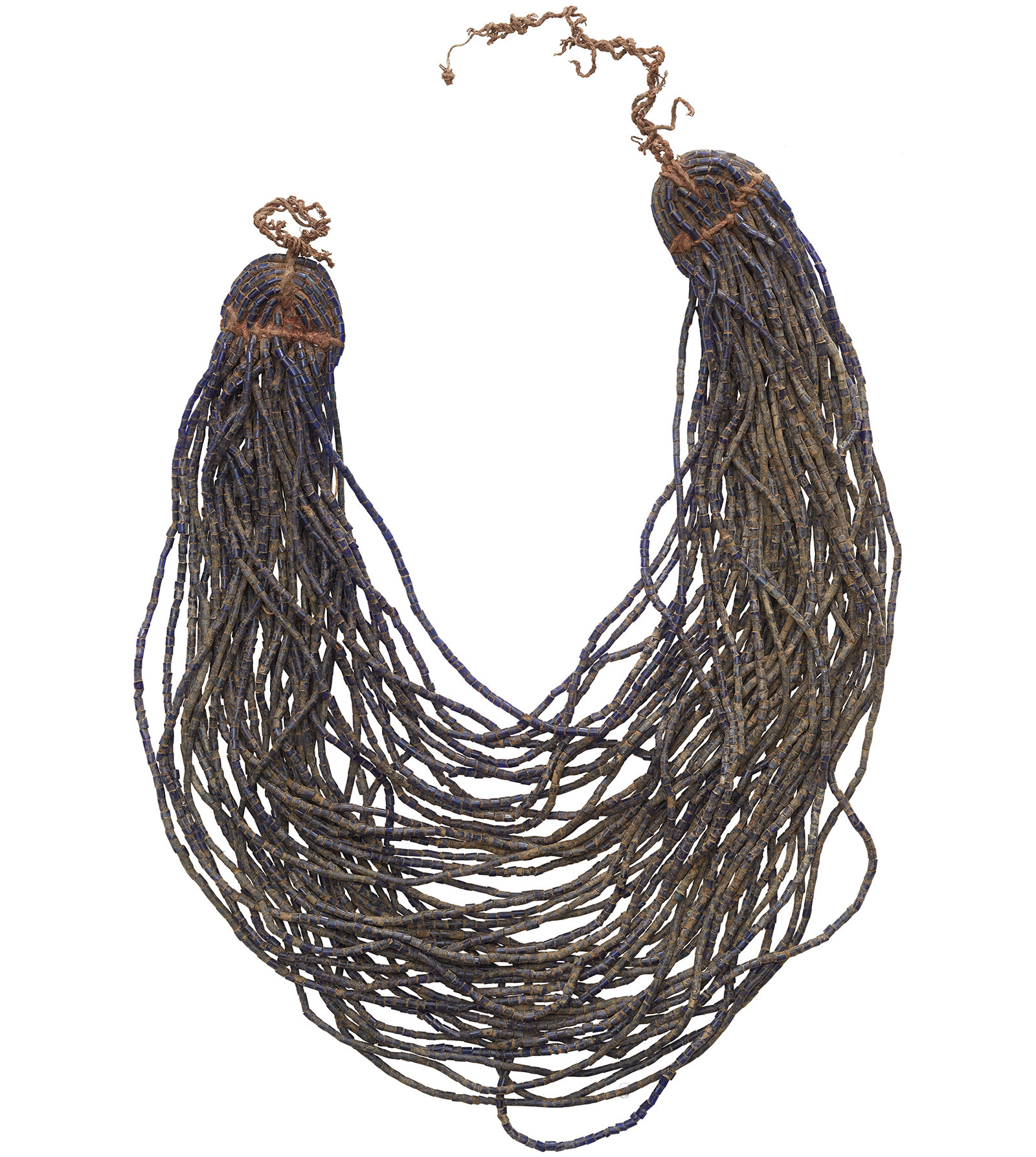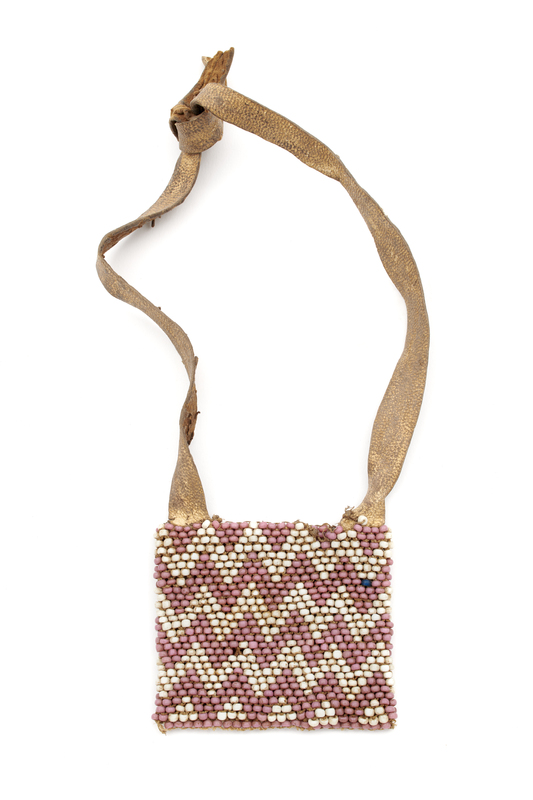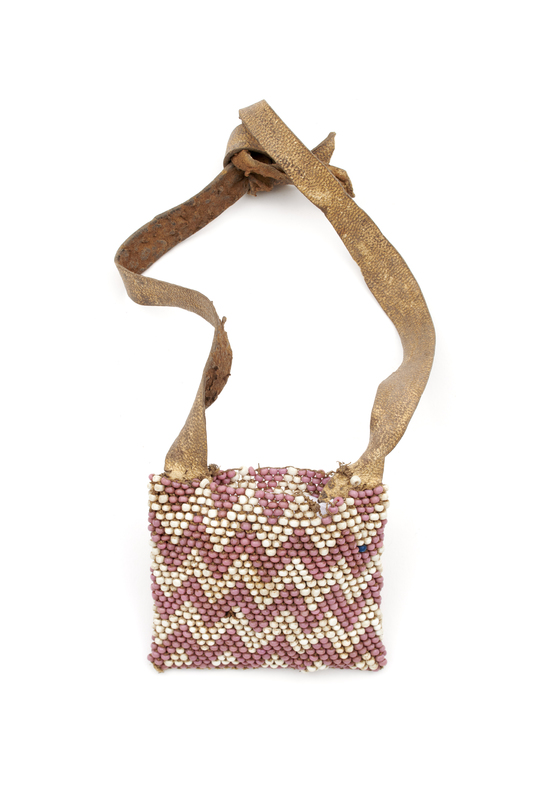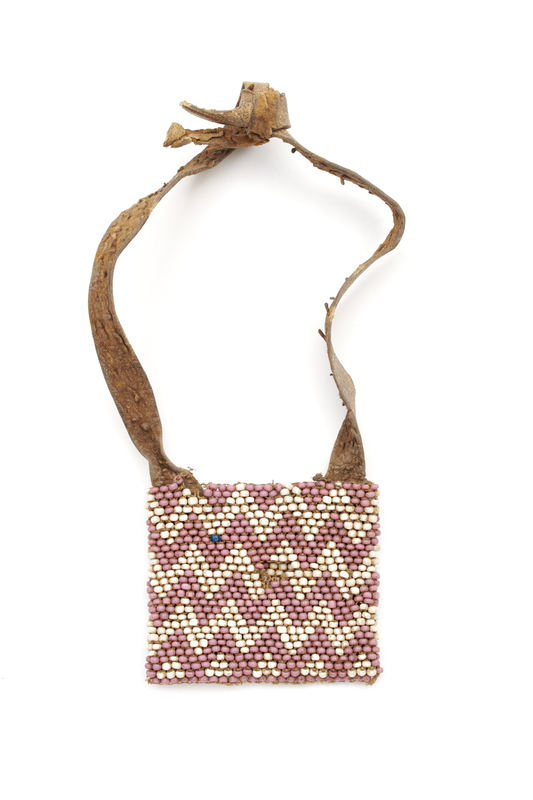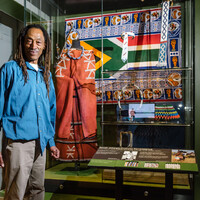Bag; Kgetse; Kgetsana; Sekgwama
Item
Title
Bag; Kgetse; Kgetsana; Sekgwama
Creator
Unrecorded
Description
Physical Description: A small bag of coloured beads. The small oblong pocket is decorated with zig-zag stripes of pink and white beadwork. Two wide, leather strings are attached to the top. This would have been used by women to carry small valuable items, tied around the waist or pinned inside clothing, since women's clothing had no pockets. [Royal Pavilion & Museums]
Contextual Description: 01:10:06 I asked a question, cos other parts of the central district, beads are still used and connected to the ancestral worship, so I asked is they had a similar thing here and he said no, on our side, beads are just for decoration. People wanting to improve how they look will use that... 01:12:30 [its for] storing personal property again because adding to the fact that the two aprons doesn’t have any pockets so this is where you put stuff. You could have it around your neck or tied to your waist and make sure that its in front so that if something drops you can see it. Transcription by KL of MAC_BB_20190817_RPM3 SL Interview with Tshupo Ntono, Village Elder, Language: Setswana with English translations by SL, 2019
Contextual Description: SL 38:11
Most of the women's attire didn't have like a safe pocket. As we've just seen those two pieces, the front and the back, I don't know what you're going to call them, they didn't have any pockets. So people …were forced to have such small bags,
SL 38:28
especially later in the time when money was introduced, I remember even in later years when I was a kid, my grandmother would have a small bag where she would put her coins which would like have around... around her neck or use a... safety pin and pin it into her dress inside like here and that's where she will always keep that small pouch
GK 38:55
But again looking...these are glass beads where? could this have been? It can be from a wealthy family who could afford...
The above notes are from a transcription by Kathleen Lawther of a discussion between Gase Kediseng, JoAnn McGregor, Nicola Stylianou, Scobie Lekhuthile and Winani Thebele which took place at the Khama III Memorial Museum on the 5th of August 2019. To listen to the full recording please follow the link below.
Most of the women's attire didn't have like a safe pocket. As we've just seen those two pieces, the front and the back, I don't know what you're going to call them, they didn't have any pockets. So people …were forced to have such small bags,
SL 38:28
especially later in the time when money was introduced, I remember even in later years when I was a kid, my grandmother would have a small bag where she would put her coins which would like have around... around her neck or use a... safety pin and pin it into her dress inside like here and that's where she will always keep that small pouch
GK 38:55
But again looking...these are glass beads where? could this have been? It can be from a wealthy family who could afford...
The above notes are from a transcription by Kathleen Lawther of a discussion between Gase Kediseng, JoAnn McGregor, Nicola Stylianou, Scobie Lekhuthile and Winani Thebele which took place at the Khama III Memorial Museum on the 5th of August 2019. To listen to the full recording please follow the link below.
Publisher
Making African Connections
Date
Pre 1899
Type
PhysicalObject
Format
whole: 210 x 70 mm
leather; glass
Identifier
R4007/19
Source
Collected by Reverend William Charles Willoughby, a Christian missionary, in what was then the Bechuanaland Protectorate (1885-1966). It is now the Republic of Botswana, having gained independence from Britain in 1966.
From 1889-92 Willoughby was pastor at Union Street Church, Brighton (now The Font pub). From 1893 to 1898 he worked for the London Missionary Society in Bechuanaland. He assembled this collection of objects during this period. This was a period of social and technological changes and these objects represent traditional lifestyles and skills, rather than the contemporary lives of the people Willoughby met.
Willoughby's collection was loaned to Brighton Museum in 1899 when he returned to the UK. The loan was converted into a donation in 1936, and accessioned as acquisition R4007.
Some objects were re-numbered with the WA (World Art) numbering system in the 2000s. These numbers have been reverted to the original R4007/... numbers where possible for consistency in 2019.
This object was on display in the exhibition 'Missionary Collectors' in the James Green Gallery of World Art, from July 2004 to January 2005.
This item was on temporary display in the James Green Gallery of World Art, Brighton Museum & Art Gallery, pre 2012
From 1889-92 Willoughby was pastor at Union Street Church, Brighton (now The Font pub). From 1893 to 1898 he worked for the London Missionary Society in Bechuanaland. He assembled this collection of objects during this period. This was a period of social and technological changes and these objects represent traditional lifestyles and skills, rather than the contemporary lives of the people Willoughby met.
Willoughby's collection was loaned to Brighton Museum in 1899 when he returned to the UK. The loan was converted into a donation in 1936, and accessioned as acquisition R4007.
Some objects were re-numbered with the WA (World Art) numbering system in the 2000s. These numbers have been reverted to the original R4007/... numbers where possible for consistency in 2019.
This object was on display in the exhibition 'Missionary Collectors' in the James Green Gallery of World Art, from July 2004 to January 2005.
This item was on temporary display in the James Green Gallery of World Art, Brighton Museum & Art Gallery, pre 2012
William Charles Willoughby
Botswana, Southern Africa, Africa
1893-1898
Space/Place
Botswana, Southern Africa, Africa
Cultural Group: Tswana
Rights
Creative Commons Attribution-ShareAlike 4.0 International
Item sets
Linked resources
Filter by property
| Title | Alternate label | Class |
|---|---|---|
 Beadwork Beadwork |

